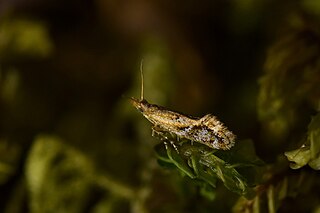
Heterocrossa gonosemana is a species of moth in the family Carposinidae. It is endemic to New Zealand.

Mnesarchaea paracosma is a species of primitive moths in the family Mnesarchaeidae. It is endemic to New Zealand and can be found in the Kaikōura, mid and south Canterbury, MacKenzie, Otago Lakes, Central Otago, Dunedin, Fiordland and Southland areas. M. paracosma lives in a wide variety of habitats including tussock grasslands, shrubland, and damp native beech or podocarp forests, at a range of altitudes from around sea-level up to 1200 m. Adults of this species are on the wing from October to February and are day flying, although they are attracted to light at night.
Helcystogramma gradatum is a moth in the family Gelechiidae. It was described by Edward Meyrick in 1910. It is known from north-eastern India.
Hypatima isotricha is a species of moth in the family Gelechiidae. It was described by Edward Meyrick in 1921. It is found on Java in Indonesia.
Athrips neograpta is a moth of the family Gelechiidae first described by Edward Meyrick in 1914. It is found in Namibia and South Africa.
Scrobipalpa sibila is a moth in the family Gelechiidae. It was described by Edward Meyrick in 1921. It is found in Mozambique.
Commatica lupata is a moth in the family Gelechiidae. It was described by Edward Meyrick in 1914. It is found in Guyana and Peru.
Compsosaris testacea is a moth in the family Gelechiidae. It was described by Edward Meyrick in 1914. It is found in Guyana.
Battaristis ichnota is a moth of the family Gelechiidae. It was described by Edward Meyrick in 1914. It is found in Guyana.
Idiophantis disparata is a moth of the family Gelechiidae. It was described by Edward Meyrick in 1923. It is found on Fiji.
Photodotis prochalina is a moth of the family Gelechiidae. It was described by Edward Meyrick in 1911. It is found in South Africa.
Orphnolechia acridula is a moth of the family Depressariidae first described by Edward Meyrick in 1918. It is found in French Guiana.
Comotechna parmifera is a moth in the family Depressariidae. It was described by Edward Meyrick in 1921. It is found in Peru and Pará, Brazil.
Comotechna scutulata is a moth in the family Depressariidae. It was described by Edward Meyrick in 1921. It is found in Brazil.
Comotechna semiberbis is a moth in the family Depressariidae. It was described by Edward Meyrick in 1921. It is found in Peru.
Eutorna insidiosa is a moth in the family Depressariidae. It was described by Edward Meyrick in 1910. It is found in India (Assam).
Psittacastis argentata is a moth in the family Depressariidae. It was described by Edward Meyrick in 1921. It is found in Brazil.
Psittacastis pictrix is a moth in the family Depressariidae. It was described by Edward Meyrick in 1921. It is found in Colombia.
Stenoma picrantis is a moth in the family Depressariidae. It was described by Edward Meyrick in 1930. It is found in Pará, Brazil.

Trachypepla lichenodes is a moth of the family Oecophoridae first described by Edward Meyrick in 1883. It is endemic to New Zealand and has been found in both the North and South Islands. It inhabits native forest and adults of this species are on the wing from November to January. The adult moths are similarly coloured to native lichen species however this colouration is variable in the extent and depth on the forewings.


